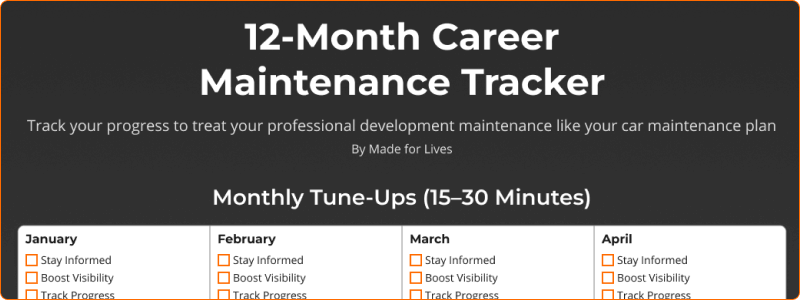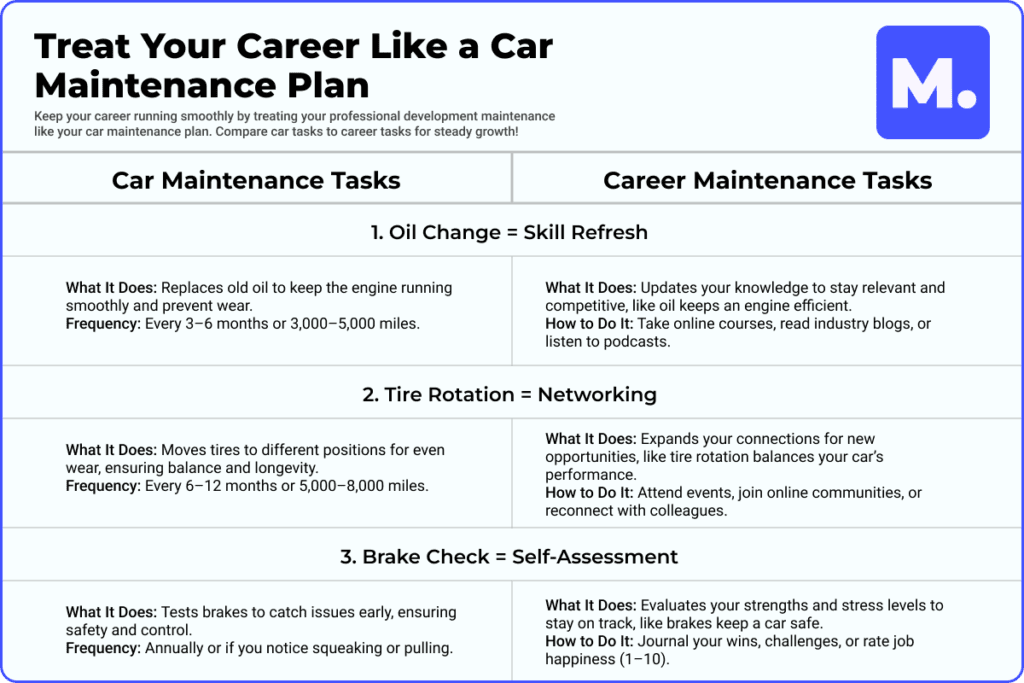Picture your career stalling like a neglected car. Rusty skills, fading connections, and stalled goals can grind your progress to a halt. To treat your professional development maintenance like your car maintenance plan keeps you sharp and racing forward. This guide delivers a 12-month strategy to upskill, overcome setbacks, and thrive in a competitive job market. Let’s roll.
- 1. Why Neglecting Your Career Maintenance Plan Hurts
- 2. How to Treat Your Career Like Car Maintenance
- 3. 12-Month Career Tracker: Treat Professional Development Like Car Maintenance
- 4. Career Maintenance Checklist
- 5. What’s Next?
- 6. Handle Setbacks with a Career Maintenance Plan
- 7. Tools to Treat Your Professional Development Like Car Maintenance
- 8. Upgrade Your Career with Professional Development Tips
- 9. Stay Ahead: Treat Your Professional Development Like Car Maintenance
Why Neglecting Your Career Maintenance Plan Hurts
Skip car maintenance, and you’re stuck with a breakdown. Ignore your career, and you risk becoming irrelevant. Without consistent effort, your expertise fades, and opportunities slip away. A career maintenance plan ensures you stay agile and ready for what’s next.
Neglect creeps in quietly. You might skip a webinar, leave your LinkedIn profile untouched, or avoid learning new software. These small oversights add up. Suddenly, a colleague lands the promotion you wanted because they mastered that new tool.
Or your industry pivots, perhaps to automation, and you’re left catching up. Routine care, like checking your car’s oil, prevents these stalls. To treat your professional development maintenance like your car maintenance plan means building habits that keep you proactive and prepared, not scrambling when change hits.
How to Treat Your Career Like Car Maintenance
The parallels between car care and professional growth are clear. Here’s how to treat your career like car maintenance with practical steps:
- Skill Refresh: Update your knowledge with online courses, industry newsletters, or podcasts, just like oil changes keep an engine running smoothly. For example, a marketer might learn SEO analytics to stay relevant.
- Flexibility: Volunteer for new projects or roles, similar to rotating tires for even wear, find remote work if you are too busy with your other duties. For example, teacher could lead a tech workshop to broaden their impact.
- Self-Check: Evaluate your strengths and stress levels regularly, like testing brakes to avoid crashes. A quick journal entry can reveal if you’re thriving or just coasting.
These habits work for any profession, from coders to chefs. A career maintenance plan fuels your ambition and keeps you competitive.
12-Month Career Tracker: Treat Professional Development Like Car Maintenance
You don’t fix a car every day, and your career doesn’t need constant overhauls. Spread out your efforts with this 12-month career maintenance tracker to stay on track:

1. Monthly (15–30 Minutes)
Keep your career engine humming with small tune-ups that build momentum.
| What to do? | How? | Example |
|---|---|---|
| Stay Informed | Read an industry article, join a Twitter Spaces discussion, or watch a TED Talk on leadership trends. | A designer might follow Smashing Magazine for UI/UX trends, while a teacher could explore Edutopia for innovative classroom strategies. |
| Boost Visibility | Refine your LinkedIn headline or share a post about a recent project win to strengthen your online presence. | Update your headline to “Marketing Specialist Driving Campaign Success” or post about a recent client win to attract recruiters. |
| Track Progress | Review one career goal (e.g., “improve public speaking”) and log a small step, like practicing a pitch for 10 minutes. | A project manager might note they joined a Toastmasters session to build confidence in team meetings. |
Strategy
Set one micro-goal each month (e.g., “learn one new skill”) and track it in a journal or app like Notion to stay accountable.
2. Quarterly (2–4 Hours)
Perform a deeper check, like an oil change, to fuel lasting career growth and adaptability.
| What to do? | How? | Example |
|---|---|---|
| Upskill Intentionally | Complete a short course or workshop aligned with your career goals, such as Coursera’s data visualization module or a leadership webinar. | A salesperson might take a Udemy course on negotiation skills, while a coder could learn Python basics to tackle new projects. |
| Expand Connections | Attend a virtual networking event, join an industry Slack group, or schedule a coffee chat with a mentor or peer. | A marketer could join a Slack community like #MarketingTwitter, while a nurse might attend a healthcare webinar to meet peers. |
| Experiment Creatively | Take on a small project outside your comfort zone, like writing a blog post or leading a team meeting, to build versatility. | A financial analyst might create a personal finance blog post on Medium to practice communication skills, or a teacher could lead a school workshop on tech tools. |
Strategy
Align quarterly tasks with a broader goal (e.g., “land a promotion by year-end”). Break it into steps:
- Q1 (learn a skill)
- Q2 (network)
- Q3 (lead a project)
- Q4 (pitch for the role).
Use a planner to schedule these tasks and review progress.
3. Annually (1–2 Days)
Schedule a full inspection to ensure your career is road-ready for the long haul and set up for future success.
| What to do? | How? | Example |
|---|---|---|
| Review and Refresh | Update your resume, LinkedIn profile, and portfolio with new skills, projects, or certifications earned over the year. | A designer adds recent UI/UX projects to their portfolio, while a salesperson highlights a record-breaking quarter on LinkedIn. |
| Set Ambitious Goals | Define one major goal for the next year, like earning a certification, switching industries, or stepping into leadership, and map the steps to achieve it. | A nurse aims to specialize in pediatrics, researching programs and setting a timeline to apply by Q3, or a coder targets a senior developer role by mastering React and leading a project. |
| Assess Alignment | Rate your job satisfaction (1–10) and identify one area to improve, such as work-life balance, salary, or role fit, then take action. | A teacher rating their satisfaction at 6/10 might request flexible hours, while a marketer might negotiate a raise after exceeding KPIs. |
| Reflect and Pivot | Write a year-end reflection on your growth, challenges, and wins, and adjust your career path if needed (e.g., pivot to a new field). | A retail manager realizes they’re passionate about data analytics, enrolling in a bootcamp to transition, or a writer shifts to freelance after building a side hustle. |
Strategy
Use a SWOT analysis (Strengths, Weaknesses, Opportunities, Threats) to evaluate your career. List your skills (strengths), gaps (weaknesses), trends to leverage (opportunities), and risks like industry shifts (threats). Plan your next year based on this insight—e.g., upskill to address a weakness or network to seize an opportunity.
Visualize your career maintenance plan with our free 12-Month Career Maintenance Tracker, which you can download here: https://madeforlives.com/career-maintenance-tracker/.
Break these tasks down further with our Career Maintenance Checklist below, designed to help you treat your professional development maintenance like your car maintenance plan with clear, actionable steps:
Career Maintenance Checklist
Keep your career running smoothly with this checklist, inspired by our guide to treat your professional development maintenance like your car maintenance plan. Check off these tasks to stay sharp, connected, and on track for your goals. Small steps lead to big wins—let’s keep your career engine purring!
Monthly Tune-Ups (15–30 Minutes)
☐ Learn Something New: Read an industry article, watch a TED Talk, or listen to a podcast.
Example: A coder might skim a blog on JavaScript frameworks; a teacher could explore Edutopia for classroom tips.
☐ Polish Your Presence: Update your LinkedIn headline or share a quick post about your work.
Example: “Marketing Specialist Optimizing Campaigns for Impact” or a note on a recent project win.
☐ Connect with Someone: Email a colleague, comment on an X post, or join a virtual chat.
Example: Message a peer about a conference or thank a mentor for past advice.
Quarterly Check-Ins (2–4 Hours)
☐ Upskill with Purpose: Complete a short course or workshop relevant to your role.
Example: A marketer might take Coursera’s SEO Fundamentals; a nurse could learn telehealth basics on Udemy.
☐ Expand Your Network: Attend a webinar, industry meetup, or coffee chat.
Example: Join a Slack group like Product Hunt for techies or a local HR event for recruiters.
☐ Reflect on Progress: Journal about your wins, challenges, and next steps.
Example: Note if you led a project successfully or felt stuck in meetings to adjust your approach.
Annual Overhauls (1–2 Days)
☐ Update Your Tools: Revise your resume, portfolio, or GitHub to reflect new skills.
Example: A designer adds recent UI/UX projects; a salesperson highlights closed deals.
☐ Set Bold Goals: Pick one big target for the year, like a promotion or career pivot.
Example: Aim to manage a team by Q4 or transition to data analysis with a bootcamp.
☐ Assess Job Fit: Rate your work happiness (1–10) and tweak one thing, like hours or tasks.
Example: Request remote work flexibility or pitch a passion project to your boss.
Download this checklist as a PDF here: https://madeforlives.com/career-maintenance-checklist/.
What’s Next?
Even five minutes counts, like checking tire pressure before a trip. To treat your professional development maintenance like your car maintenance plan prioritizes steady progress over perfection, building momentum with every step.
See how routine car care translates to career growth in this visual guide below:

You can download this infographic here: https://madeforlives.com/career-maintenance-infographic/.
Handle Setbacks with a Career Maintenance Plan
Careers, like cars, face rough patches. A job loss feels like a flat tire, a skill gap resembles worn brakes, and burnout mimics an overheating engine. Knowing how to treat your career like car maintenance helps you recover quickly:
- Job Loss: Rebuild momentum like swapping a tire. Polish your resume, reach out to a mentor, or enroll in a free course, such as Google’s IT Support Certificate. A graphic designer might freelance on Upwork to bridge the gap.
- Skill Gaps: Close them with quick learning, like tightening brakes. Watch a YouTube crash course on tools like Tableau for data analysis. A retail manager could learn inventory software to boost efficiency.
- Burnout: Recharge like cooling an engine. Take a mental health day, decline non-essential tasks, or confide in a friend. A software developer might try meditation apps like Headspace to reset focus.
- Job Rejection: Be strong as a car’s mind. Analyze your experience, take a brake and discover how to move forward after job rejection.
Listen to your instincts. Feeling stuck, dreading work, or struggling with familiar tasks signals trouble. Don’t go it alone. A career coach, trusted peer, or podcast like How I Built This can offer perspective. For example, a teacher feeling overwhelmed might join an online educators’ group to share strategies. A career maintenance plan equips you to fix problems early, ensuring you stay on course. But don’t forget about your work-life balance state, which can lead to more successful results on your way.
Tools to Treat Your Professional Development Like Car Maintenance
Every car needs a toolkit, and so does your career. Stock these essentials to stay prepared:
- Self-Knowledge: Understand your strengths, like knowing a car’s specs. Are you a strategic thinker or a creative problem-solver? Free tools like CliftonStrengths or 16Personalities clarify your edge. A financial analyst might discover they excel at communication, opening doors to advisory roles.
- Network: Keep connections active, like jumper cables for a dead battery. Send a quick note to a former colleague or join a Slack community in your field. A writer could engage in #WritingCommunity on X for feedback.
- Side Skills: Develop a backup, like carrying a spare tire. A side hustle, such as tutoring or Etsy crafts, adds security. An accountant might teach QuickBooks online for extra income.
- Goals: Set a clear target, like a GPS route. Want to lead a team by year’s end? Break it into steps: shadow a manager, take a leadership course, pitch a project.
These tools build resilience. They’re your safety net for unexpected turns in the job market.
Upgrade Your Career with Professional Development Tips
A career maintenance plan prevents stalls, but professional development tips accelerate your journey. Think of a new credential, a bigger role, or a passion project as a performance upgrade for your career. Also, remember to study future workplace trends.
Consider the trends shaping your field. A marketer might study AI-driven advertising to stay ahead. A teacher could pursue a master’s in curriculum design to influence school policy. Even small upgrades matter, like turning a photography hobby into client work.
These moves position you as a leader, not a follower. For instance, a logistics coordinator who learns supply chain analytics could pitch cost-saving ideas, earning a promotion. To treat your professional development maintenance like your car maintenance plan means maintaining the basics and chasing bold wins to outpace the competition.
Stay Ahead: Treat Your Professional Development Like Car Maintenance
Your career drives your dreams. Neglect it, and you’re stuck in the slow lane, watching others pass. But treat your professional development maintenance like your car maintenance plan, and you’ll navigate any road with confidence.
Start today. Choose one action: sign up for a free course on platforms like edX, send a “let’s catch up” message to a mentor, or spend an hour refreshing your resume. The job market waits for no one, so take the wheel now.

Hlib, Editor-in-Chief at Made for Lives, writes in-depth guides on jobs, careers, and work-life balance to help readers thrive professionally.

